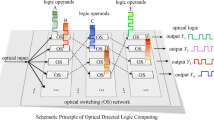Abstract
Optical channels are currently able to carry 10 Gbit/s and even 40 Gbit/s traffic flows. However, it is not usual to have such amounts of traffic between any pair of client nodes. This article proposes using point-to-multipoint optical channels for the allocation of point-to-point connections in transparent wavelength-routed optical networks. Specifically, when an optical connection between a source-destination node pair has to be established, the optical signal is also sent to some adjacent nodes by introducing passive optical splitters; in this way a light-tree is built. Then, the already established point-to-multipoint optical channel can be used to groom further point-to-point connections between the same source node and each of the other nodes composing the light-tree. The benefits of this strategy are 2-fold: first, the reduction of optical transmission equipments allowing cost savings with respect to the traditional typical point-to-point approach and, second, the optimization of the optical channels utilization meeting in such a way Traffic Engineering objectives. The merits of proposed approach are evaluated by simulation.
Similar content being viewed by others
References
Ramaswami, R. (2002). Optical networks: A practical perspective (2nd ed) (Ed.), Morgan Kaufmann Publishers.
Hu, J. Q., & Leida, B. (2004). Traffic grooming, routing, and wavelength assignment in optical WDM mesh networks. In Proc. of IEEE INFOCOM ‘04 (Vol. 1, pp. 495–501) Hong Kong, China, March 2004.
Sahasrabuddhe L. et al. (1999) Light-Trees: Optical multicasting for improved performance in wavelength-routed networks. IEEE Communications Magazine 37(2): 67–73
Mukherjee, B. (1997). Optical communications networks. McGraw-Hill.
Rouskas G.N. (2003) Optical layer multicast: Rationale, building blocks and challenges. IEEE Network 17(1): 60–65
Ali M. et al. (2000) Cost-effective implementation of multicasting in wavelength-routed networks. IEEE Journal on Selected Areas of Communications 18(10): 1852–1862
Ali M. (2002) Optimization of splitting node placement in wavelength-routed optical networks. IEEE Journal on Selected Areas of Communications 20(10): 1571–1580
Gerstel O. et al. (2000) Cost effective traffic grooming in WDM rings. IEEE/ACM Transactions on Networking 8(5): 618–630
Chi A. et al. (2000) Traffic grooming algorithms for reducing electronic multiplexing costs in WDM ring network. IEEE/OSA Journal of Lightwave Technology 18(1): 2–12
Comellas J. et al. (2003) Integrated IP/WDM routing in GMPLS based optical networks. IEEE Network 17(2): 22–27
Birman, A., & Kershenbaum, A. (1995). Routing and wavelength assignment methods in single-hop all optical networks with blocking. In Proc. of IEEE INFOCOM ‘95 (Vol. 2, pp. 431–438). Boston, MA, USA, April 1995.
Madhyastha, H., Srinivas, N., Chowdhary, G., & Murthy, C. (2003). Grooming of multicast sessions in WDM ring networks. In Proceedings of optical networking and communications (OptiComm ‘03) (Vol. 1, pp. 1–12). Dallas, TX, USA, October 2003.
Billah, A., Wang, B., & Awwal, A. (2003). Multicast traffic grooming in WDM optical mesh networks. In Proceedings of IEEE GLOBECOM ‘03 (Vol. 5, pp. 2755–2760). San Francisco, CA, USA, December 2003.
Kamal, A., & Ul-Mustafa, R. (2003). Multicast traffic grooming in WDM networks. In Proceedings of optical networking and communications (OptiComm ‘03) (Vol. 1, pp. 25–36). Dallas, TX, USA, October 2003.
Huang X. et al. (2005) Multicast traffic grooming in wavelength-routed WDM mesh networks using dynamically changing light-trees. IEEE Journal of Lightwave Technology 23(10): 3178–3187
Yang, D., & Liao, W. (2003). Design of light-tree based logical topologies for multicast streams in wavelength routed optical networks. In Proceedings of IEEE INFOCOM ‘03 (Vol. 1, pp. 32–41). San Francisco, CA, USA, April 2003.
Hwang F. et al. (1992) The steiner tree problem. Elsevier, The Netherlands
Jourdanm A. et al. (1996) Design and implementation of a fully reconfigurable all-optical crossconnect for high capacity multiwavelength transport networks. IEEE/OSA Journal of Lightwave Technology 14(6): 1198–1206
Vasilyev M. et al. (2003) Transparent ultra-long-haul DWDM networks with broadcast-and-select OADM/OXC architecture. IEEE/OSA Journal of Lightwave Technology 21(11): 2661–2672
Author information
Authors and Affiliations
Corresponding author
Rights and permissions
About this article
Cite this article
Spadaro, S., Comellas, J., D’Angelo, G. et al. Allocating point-to-point connections over point-to-multipoint optical channels. Photon Netw Commun 14, 71–81 (2007). https://doi.org/10.1007/s11107-007-0056-3
Received:
Accepted:
Published:
Issue Date:
DOI: https://doi.org/10.1007/s11107-007-0056-3




